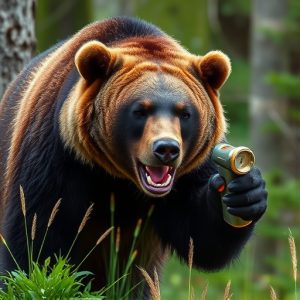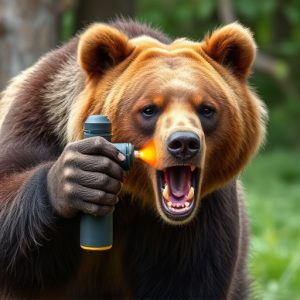Mastering Black Bear Defense: Optimal Distance & Spray Techniques
Understanding black bear behavior is key to developing effective defense strategies, especially with…….
Understanding black bear behavior is key to developing effective defense strategies, especially with bear spray. The optimal distance for deployment is 20-30 meters (65-100 feet), aiming for the bear's face and eyes within this range for maximum impact. Factors like wind, temperature, and topography influence spray range. Regular practice, high-quality sprays, and noise-making devices enhance effectiveness. Local laws govern usage, with 20-30 feet as the optimal distance. Beyond spray, maintaining this distance, proper training, food storage, and bear behavior knowledge significantly reduce risks in bear encounters.
“Bears can be an intimidating presence in many outdoor spaces, with black bears posing a significant threat. Understanding their behavior is key to staying safe. This article delves into essential aspects of bear defense, focusing on the critical ‘optimal distance for bear spray’. We explore how factors like terrain and wind affect its effectiveness, providing crucial insights for hikers and outdoor enthusiasts. Additionally, we cover application techniques, legal considerations, and safety measures, empowering readers with knowledge to navigate potential encounters confidently.”
- Understanding Black Bear Behavior and Spray Dynamics
- Factors Influencing the Optimal Distance for Bear Spray
- Application Techniques and Effective Range of Bear Spray
- Legal Considerations and Regulations for Bear Spray Use
- Additional Safety Measures and Training Tips for Encounters
Understanding Black Bear Behavior and Spray Dynamics
Understanding black bear behavior is key when considering defense strategies, especially with the use of bear spray. These intelligent and adaptable creatures have a keen sense of smell and can detect potential threats from afar. When faced with a perceived danger, they often choose to flee rather than confront, preferring to avoid direct conflict. However, if startled or cornered, black bears may become aggressive, making their behavior unpredictable in certain situations.
The optimal distance for deploying bear spray is crucial. It’s recommended to maintain a distance of at least 20-30 meters (65-100 feet) from the bear. At this range, spraying can create a barrier without directly targeting the bear, allowing you time to retreat or de-escalate the situation. Bear spray is designed to disrupt the animal’s sense of smell and temporarily stun them, providing an escape route for humans. Effective use of spray depends on understanding both bear behavior and the spray’s dynamics, ensuring safety in potential encounters.
Factors Influencing the Optimal Distance for Bear Spray
When considering the optimal distance for bear spray, several factors come into play. The effectiveness of the spray largely depends on the proximity to the bear and the specific conditions present in the environment. Wind direction and speed are critical variables; a tailwind can carry the spray away from the intended target, while a headwind might disrupt its range and accuracy. Topography also plays a role, as elevation changes can affect air currents and the spray’s drift.
Distance is best determined through practice and understanding of the spray’s recommended usage guidelines. In general, bear spray should be applied at close to medium range—typically within 20 to 30 feet (6 to 9 meters)—for maximum impact. This allows for direct contact with the bear’s face, which is key to neutralizing it quickly. However, users must remain alert and ready to adjust their position if needed, as bears can react unpredictably.
Application Techniques and Effective Range of Bear Spray
When using bear spray, understanding application techniques is key to its effectiveness. Aim for the bear’s face and eyes, as this area contains many sensory organs. At close range (between 20-30 feet), directly spraying into the bear’s face will give you maximum impact. However, if caught off guard, spraying from a farther distance (up to 100 feet) can still deter an aggressive bear. The key is to ensure proper coverage of the animal’s eyes and nose, as this disrupts their senses and triggers a reaction to flee.
The optimal distance for bear spray varies based on factors like sprayer quality and weather conditions. Colder temperatures can cause the spray to solidify slightly, reducing its range. Conversely, windy conditions may dissipate the spray too quickly to be effective. For best results, practice your application techniques in controlled settings and choose a spray designed for maximum range and durability. Always remember that bear spray is just one tool in your safety kit; it’s crucial to combine this with noise-making devices and escape routes when encountering bears in the wild.
Legal Considerations and Regulations for Bear Spray Use
In many regions where black bears roam, the use of bear spray is regulated by strict laws and guidelines to ensure responsible and safe coexistence with these wild animals. Before considering bear spray as a defense mechanism, individuals should familiarize themselves with local regulations. The optimal distance for bear spray application varies across jurisdictions, typically ranging from 20 to 30 feet (6 to 9 meters), but it’s crucial to follow specific rules set by wildlife management authorities. Failure to comply with these regulations can result in fines or other legal consequences.
Understanding the legal framework surrounding bear spray use is essential for responsible recreation and personal safety in bear country. Some areas may require permits or registration, while others might mandate specific types of spray with certain concentrations and application techniques. Bear spray should only be used as a last resort when physical attack seems inevitable; proper bear behavior awareness and prevention methods should always be prioritized.
Additional Safety Measures and Training Tips for Encounters
When it comes to black bear encounters, going beyond just carrying bear spray is crucial. Additional safety measures can significantly enhance your chances in a potential encounter. One key factor to remember is maintaining the optimal distance for bear spray—typically around 20-30 feet (6-9 meters). This allows you to deploy the spray effectively while providing enough space to escape or avoid an aggressive attack.
Training tips are also essential. Practicing deployment techniques in safe settings ensures you’re ready when faced with a real scenario. Learn how to properly handle and store your bear spray, and be aware of its range and effectiveness. Additionally, stay alert during outdoor activities, make noise to signal your presence, and carry food securely to minimize attracting bears. These precautions, combined with knowledge of bear behavior, can foster safer interactions in bear country.
Understanding black bear behavior, the dynamics of spray, and legal considerations is key to effectively defending against bears. When used correctly, bear spray can provide a crucial buffer, but knowing the optimal distance (a key factor influenced by spray factors) and proper application techniques is essential for safety. Always consult local regulations and consider additional training to ensure a responsible and effective response during encounters with these powerful animals.


